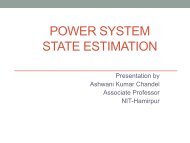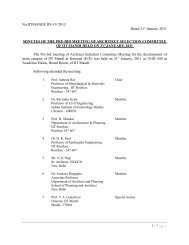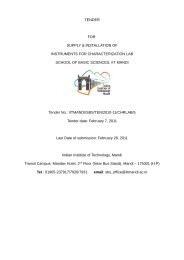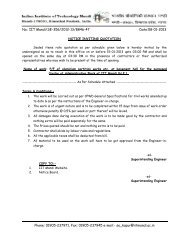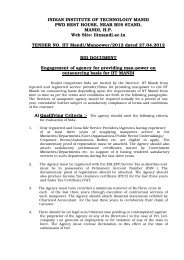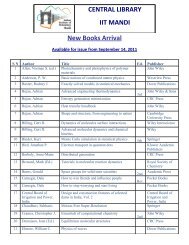Issue1. Vol.1 (April, 2013) - IIT Mandi
Issue1. Vol.1 (April, 2013) - IIT Mandi
Issue1. Vol.1 (April, 2013) - IIT Mandi
- No tags were found...
Create successful ePaper yourself
Turn your PDF publications into a flip-book with our unique Google optimized e-Paper software.
ESSENT Society for Collaborative Research and Innovation, <strong>IIT</strong> <strong>Mandi</strong>12G(Y ) = 1 + −× 6294820234.6 2(234.6) 284.13= 19.92%The value of the Gini-coefficient of the incomedistribution of all household (i.e., 0.3691) ifcompared to the value of Gini-coefficient of theincome distribution among the poor (i.e.,0.1992) clearly indicates that the inequality ofincome is higher in the former case as comparedto the later because in the former casecomparatively the value of Gini-coefficient ishigher which shows relatively more skewedincome distribution. The income of the poorestamong the poor is low due to their small size ofholding, higher the dependency ratio and lack ofregular non-form employment opportunities.The value of Gini-coefficient for theconsumer expenditure distribution on fooditems by all households has been worked outas follows:1 2 nG ( c)= 1 + − ∑ ( n + 1 − i)cin2n z i = 1G(c) = Gini-coefficient of the consumerexpenditure on food items by all householdsn= total consumer units (1448.5), z= meanconsumption expenditure (394.94)ci= consumer expenditure on food items by thenith consumer unit , ∑ ( n + 1 − i)ci = 337679020 ,i = 1Thus12G(c)= 1 + −(337679020)1448.5 2(1448.5) × 394.94= 18.57%The value of Gini-coefficient for theconsumer expenditure distribution on fooditems by poor households has been workedout as follows:1 2 qG ( c)= 1 + − ∑ ( q + 1 − i)ciq2q z i = 1G(c) = Gini-coefficient of the consumerexpenditure on food items by poor householdsq= number of poor consumer units (666.2), z =mean consumption of the poor (281.83)ci = consumer expenditure on food items by thei th poor consumer unit,q∑ ( q + 1 − i)ci = 54508260 , thusi = 112G(c)= 1 + −(54508260)666.2 2(666.2) 281.83= 12.99%The value of Gini-coefficient of the consumerexpenditure on food items of all households (i.e.0.1857) if compared to the value of Ginicoefficientof the income distribution among thepoor (i.e. 0.1299) also clearly shows that theinequality of consumer expenditure on fooditems is higher in the former case as capered tothe later. But when the value of Gini-coefficientof income distribution (among all and poor also)is compared to the value of Gini-coefficient ofthe consumer expenditure on food items (by alland poor households), it shows that the value ofGini-coefficient is higher in the former case ascompared to the later mainly due to the reasonthat food being the bare necessity of life,requires a minimum amount of income to bespent on it.Distribution of monthly consumerexpenditure on food and non-food itemsThe percentage expenditure on food and nonfooditems shows that the poor householdsspend most of their income on food items and avery little is left for meeting out the non-foodrequirements where as the ‘not poor’ householdspend comparatively less on food items andproportionately higher amount on non-fooditems.The value of Gini-coefficient for thedistribution of consumer expenditure on food& non-food items by all households has beencalculated as follows:1 2 nG ( c)= 1 + − ∑ ( n + 1 − i)ci , Wheren2n z i = 174 ESSENT|Issue1|Vol1



